Trials are in full swing down in the Southern Ocean exploring whether it’s possible to rid Auckland Island of its three remaining introduced predators – pigs, cats and mice.
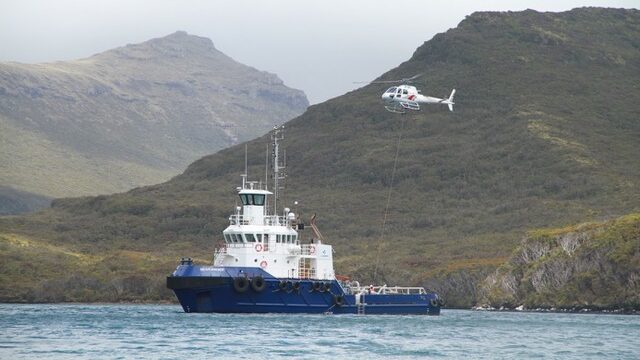
Following the successful eradication of mice from Antipodes Island, the Department of Conservation has turned its attention to the last island within the New Zealand Subantarctic Islands Area to have mammalian pests. Auckland Island is the main island of its namesake group. This archipelago is the largest and biologically richest of the five island groups which make up this region, listed as a World Heritage Site for its conservation values and biological importance.
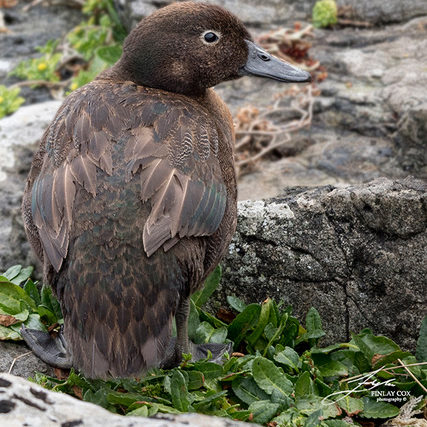
Of the 44 species of bird breed that on the islands, nine of them are endemic to the group. There are over 280 insect species, more than 95 of these endemic. Over 196 plant species call the islands home.
On Auckland Island itself however, it is a different story.
Pigs were introduced by Captain Bristow in 1807 as a food source for potential castaways landing on the island, whilst cats and mice arrived with prospective settlers in the mid 1800’s. When the settlers promptly returned to the mainland within three years, they left behind their furry companions, which have inflicted severe ecological damage over the next 150 years.
Pigs have devastated the floral communities of the island and prevent understory regeneration in the rata forest with their rooting. Along with cats, they have caused the local extinction of 32 of the breeding bird species including all the endemic ones.
Mice feed on the insects, competing with native birds for this food source and present a real future risk to seabird chicks: Mice have been seen to become predatory and attack birds on islands such as Gough Island, Marion Island and Midway Atoll, where they are the sole predatory mammal.
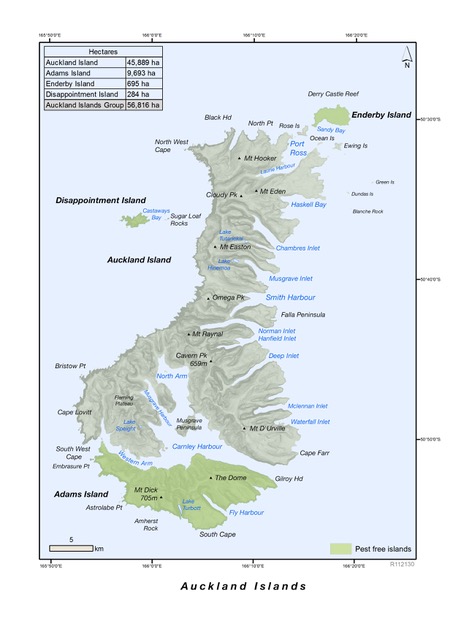
At 46 000 ha Auckland Island is the main island of its namesake group and is the fifth largest island in New Zealand. This project would be the largest island eradication ever attempted for pigs and mice and close to the largest for cats, and so is not without its challenges, not just because of its scale but because of the location.
Located 465km south of Bluff, Auckland Island is cold, wet and windy. The western coast of the island is comprised of vertiginous cliffs, whilst large swathes of it are covered in a coastal scrub which can only be travelled through on hands and knees. Aside from a few short tracks catering to tourists on cruise ships, an old six bunk hut and a few remnants of the Coastwatchers era, there is no infrastructure on the island. Add into that the notoriously wily behaviours of pigs and cats, and you have seriously ambitious project.
Over the 2018/19 summer, forty staff are working on four main research programs to look at these challenges and answer the questions: Can it be done? What would it take?
Program One: Infrastructure
First, all these staff need somewhere to stay. Flyable bivvys were constructed on the mainland, transported on a cargo ship and installed to provide a base camp near Falla Peninsula where several trials are centred. Tracks were cut at key study sites and investigations made into best locations for helipads, accommodation, storage facilities and traps.
Fencing to divide the island into manageable chunks could be a key tool in an eradication and so scoping trips were made for these as well. A temporary test fence was erected to divide the study site of Falla Peninsula from the rest of the island – a few pigs and sealions have managed to push through so the design fencing is an area for further thought. The infrastructure team also installed high speed internet at two base locations, which is great for checking the weather but not such good news for those who like island work as a break from emails…
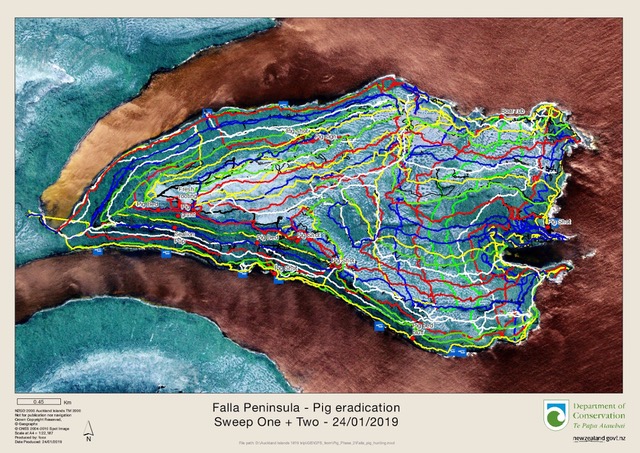
Program Two: Pigs
Whilst the method for eradication of pigs appears simple – a combination of aerial and ground hunting – the aforementioned scrub bands and weather pose serious challenges to the work. High definition thermal imaging gear is being used from a helicopter to see if we can improve the efficiency of target identification and aerial hunting. So far the team have managed to identify something as small as a kitten accurately through the scrub, although the rata forest is proving more challenging.
A team of pig hunters with dogs are testing a hunting method where they sweep across Falla Peninsula in tight formation to mop up those animals missed by the helicopter. Whilst 100% effective elsewhere, the bluffs on the island are forcing the teams to adopt a sidling pattern of movement rather than the traditional top-to-bottom. The scrub is also forcing them to crawl at times.
Whilst down there, the team are exploring the use of feeders and pig traps to see if pigs can be trained to visit specific areas and whether we can make any modifications to the pig trap design to reduce the effort of installing them across the island.
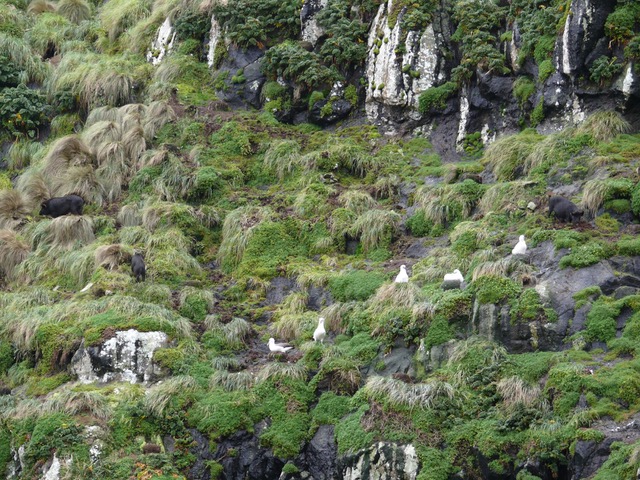
Program Three: Mice
Whilst there may be a standard eradication protocol for mice using aerially applied rodent bait containing brodifacoum, the scale of Auckland Island means the team needs to investigate the lowest possible application rate that still hits every mouse home range on the island.
The logistics of transporting, storing and applying the amount of bait required by best practice in this environment are improbable, particularly as aerial bait sowing is dependent on suitable periods of weather – a difficult ask in the Subantarctic. That is part of the reason the trial is being done in the summer, compared to the preferred winter timing when the bait is most attractive as less alternative food is available. There are more than 12 hours of workable daylight in summer compared to about 7 in winter.
Once the pigs have been removed from Falla Peninsula, the team will sow non-toxic baits containing a biomarker that fluoresces under ultra violet light. By setting out a network of mouse traps a few days after the bait has been sown, we aim to determine what percentage of the mouse population were able to come across and eat bait at these lower sowing rates. This combined with a study looking at home range sizes will help the team work out what application rates would knock out every single last mouse on the island and if summer timing while mice are still breeding is likely to succeed.
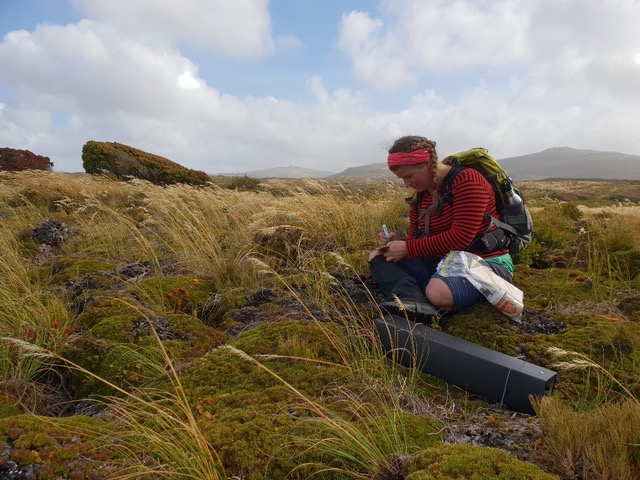
Program Four: Cats
The list of what we don’t know about cats on Auckland Island is endless. What size are their home ranges on the island? How far do they travel? Which habitats are they found in and what are they eating? How many cats ARE there on Auckland Island? How can they be effectively monitored to know when the last cat is gone: can we use trail cameras, thermal imaging, dogs? And how are these tools best used in combination?
To answer these questions there are two phases to this program: Firstly trap some cats using live capture traps and put GPS tracking collars on them to see how they use the island and interact with each other. Secondly, wait a month and put out a grid of trail cameras and bring in two dog handlers to see how many cats we managed to catch or didn’t catch using the leg hold traps, and work out how well these methods can detect cats and what effort is required.
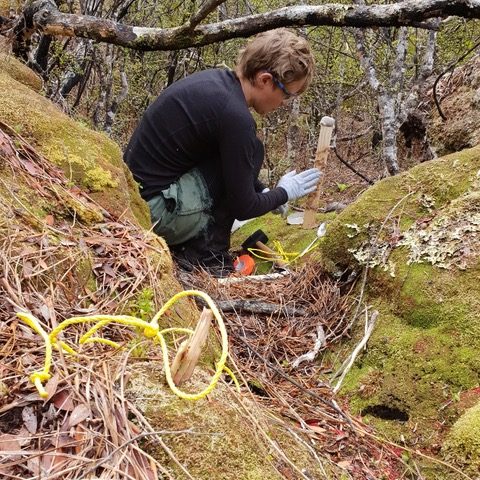
Cat scats will also be collected in the search area for DNA testing. The results will be compared to DNA from mouth swabs taken from captured cats – hopefully giving us a clear picture on how many cats we didn’t detect using all the other methods. It is all about determining confidence in the suite of methods to validate eradication.
On top of these four programs this summer, the team is also installing a suite of biodiversity monitoring tools to measure the impact of the three predators on the island and to estimate the potential benefits of their removal. A dedicated team of GIS experts are using high definition satellite imagery and drones to help plan the infrastructure programme from the comfort of their office. Teams of experts are looking at developing new control methods, for example a cat targeted toxin which could be distributed by air, something that we don’t currently have in New Zealand.
With the last of the island teams due back in March, we have a long winter of analysing our results and planning the next steps in this hugely ambitious, challenging and exciting project. Hopefully you will follow us along the way as we try to bring the birds back to Auckland Island and make New Zealand’s Subantarctic islands the wildlife haven they should be.

